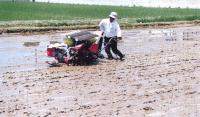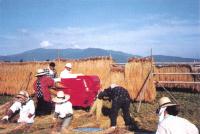
|

|
| Transplanting rice seedlings by machine. | Church volunteers help thresh rice. |

|

|
| Transplanting rice seedlings by machine. | Church volunteers help thresh rice. |

|
| Non-manured paddy fields in foreground unaffected by the 1982 blight; compare with adjacent manured fields in back. |
| Table of Contents | Previous Page | Next Page |